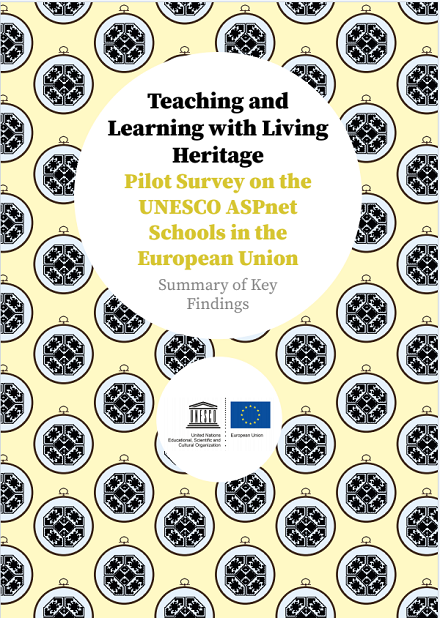2021_Teaching and Learning with Living Heritage Pilot Survey on the UNESCO ASPnet Schools in the European Union, Maristela Simão (Coord), Ângelo Biléssimo, Érica Abreu Gonçalves, Marcelo Lages Murta, Nathalia Pamio, Ed. UNESCO
2021
The design and implementation of the survey were carried out by a team of five researchers from the UNESCO Chair on Education, Citizenship and Cultural Diversity at the Lusófona University in Lisbon, Portugal. We thank Maristela Santos Simão for her leadership in conducting the research, as well as her colleagues Angelo Biléssimo, Érica de Abreu Gonçalves, Marcelo Lages Murta and Nathalia Pamio for their expertise, time and dedication.
Published in 2021 by the United Nations Educational, Scientific and Cultural Organization, 7, place de Fontenoy, 75352 Paris 07 SP, France. © UNESCO 2021 This publication is available in Open Access under the Attribution-ShareAlike 3.0 IGO (CC-BY-SA 3.0 IGO) license (http://creativecommons.org/licenses/by-sa/3.0/igo/). By using the content of this publication, the users accept to be bound by the terms of use of the UNESCO Open Access Repository (http://www.unesco.org/open-access/termsuse-ccbysa-en).
This survey on teaching and learning with living heritage represents an initial effort to document the integration of intangible cultural heritage (ICH) in school-based learning among the UNESCO Associated Schools Network (ASPnet) across the European Union, and to identify possible opportunities and challenges for teachers and learners when working with living heritage in curricular or extracurricular activities. Intangible cultural heritage,1 or living heritage, refers to the knowledge, practices and expressions that are passed down from generation to generation, in families and communities everywhere around the world. Living heritage is continuously recreated in response to an ever-changing environment and provides communities with a sense of identity and continuity, thus promoting respect for cultural diversity and human creativity. Intangible cultural heritage includes oral traditions, performing arts, social practices, rituals and festive events, knowledge and practices concerning nature and the universe, and the knowledge and skills related to craftsmanship. Schools can play a key role in the intergenerational transfer of knowledge through activities that integrate the living heritage present in their communities. In addition to safeguarding this heritage, these efforts help to increase the quality of education by making it more relevant to students’ realities, thus contributing to Sustainable Development Goal 4 on Quality Education. As the results of this survey make clear, these activities also create links between the school and students’ families and communities, as well as fostering an appreciation of diversity
Dpwnload https://ich.unesco.org/doc/src/Teaching_and_Learning_with_Living_Heritage.pdf

